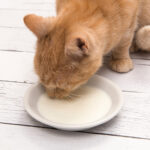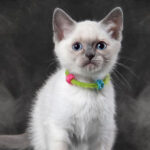Every cat owner is likely familiar with the unsettling sound of their feline friend retching, followed by the less-than-pleasant sight of a hairball. While seemingly disgusting, hairballs are a common occurrence for cats. But what exactly are they, why do they happen, and when should you be concerned? This guide will delve into the world of Cat Hairballs, providing you with essential information on their causes, potential dangers, and effective prevention strategies.
What Exactly Are Cat Hairballs?
Despite their name, cat hairballs aren’t actually ball-shaped. More accurately described as trichobezoars, these regurgitated masses are typically cylindrical and elongated, often resembling a cigar or sausage. This distinctive shape comes from the narrow passage of the esophagus, the tube that carries food from the mouth to the stomach. Dr. Richard Goldstein, a veterinary expert at Cornell University’s College of Veterinary Medicine, explains that hairballs only become round if they remain undigested in the stomach for a prolonged period, taking on a form similar to “a sponge or a rolled-up sock.”
These expelled hairballs vary in size, generally around an inch in length but capable of reaching up to five inches long and an inch in thickness. Their color is usually dictated by the cat’s coat, darkened by food pigments and digestive fluids like bile, which can give them a greenish tinge. While not pleasant, the odor is typically bearable.
The Journey of a Hairball: From Grooming to… Well, You Know.
Hairballs are an unfortunate byproduct of a cat’s meticulous grooming habits. Cats are fastidious groomers, and their tongues are covered in tiny, backward-facing barbs called papillae. These papillae act like a natural comb, effectively trapping loose hair as the cat grooms itself. This hair is then propelled down the throat and into the stomach.
According to Dr. Goldstein, the primary component of hair, keratin, is indigestible. While most of the swallowed hair passes through the digestive system and is excreted in feces, some hair inevitably remains in the stomach. Over time, this accumulated hair clumps together, forming the damp mass we know as a hairball.
When Hairballs Become a Problem: Potential Hazards
Occasional hairball regurgitation, perhaps once every week or two, is generally considered normal for cats and is usually just a minor inconvenience for owners. However, hairballs can pose a serious health risk if they grow too large to pass through the digestive tract. A significant danger arises when a hairball obstructs the sphincters, the muscular rings that control the passage of food between the esophagus and stomach, or between the stomach and intestines.
Even more concerning, though less common, is when a hairball manages to pass into the small intestine and becomes lodged there. Dr. Goldstein emphasizes that such intestinal blockages are critical situations. Without prompt surgical intervention, these blockages can be fatal.
Recognizing When to Seek Veterinary Help
It’s crucial to differentiate between normal hairball expulsion and signs of a more serious issue. Consult your veterinarian immediately if your cat exhibits any of the following symptoms:
- Lethargy or weakness: A noticeable decrease in energy levels.
- Loss of appetite: Refusal to eat for more than 24-48 hours.
- Repeated unproductive retching: Gagging or hacking without producing a hairball.
- Vomiting: Expelling stomach contents, especially if frequent or forceful.
These symptoms might not always indicate hairballs and could signal other gastrointestinal problems or even respiratory issues like asthma. In such cases, timely veterinary treatment is essential.
Diagnosis and Treatment
Diagnosing a hairball-related intestinal blockage involves a comprehensive veterinary examination. This typically includes a physical assessment, bloodwork, X-rays, and potentially ultrasound imaging. The veterinarian will also consider the cat’s history of hairball regurgitation.
If a blockage is confirmed, surgery might be necessary to physically remove the obstructing hairball. However, in many cases, treatment focuses on supportive care to help the hairball pass naturally through the digestive system. This often involves hospitalization and the administration of laxatives to lubricate and facilitate the movement of the hairball.
Important Note: Dr. Goldstein strongly advises against administering any laxatives to your cat without prior consultation and guidance from a veterinarian. Similarly, the use of commercial “hairball control” diets should be discussed with your vet to ensure they are appropriate for your cat’s specific needs.
Hairball Prevention Strategies
Preventing hairballs is always preferable to treating them. Here are some effective strategies to minimize hairball formation in your cat:
- Regular Grooming: Brushing your cat frequently, especially long-haired breeds, helps remove loose hair before it can be ingested during self-grooming.
- Hairball-Specific Diets: Certain cat foods are formulated with higher fiber content to aid in the passage of hair through the digestive tract. Consult your vet to see if a hairball diet is suitable for your cat.
- Laxative Treats or Gels: Veterinarian-approved hairball laxatives, often in treat or gel form, can help lubricate the digestive system and facilitate hair passage. Always use these under veterinary guidance.
- Hydration: Ensuring your cat stays well-hydrated can help keep the digestive system functioning smoothly.
Conclusion
While the occasional hairball might be a normal part of cat ownership, understanding the potential risks and implementing preventative measures is vital for your cat’s health and well-being. By being proactive with grooming, considering dietary adjustments, and seeking veterinary advice when needed, you can effectively manage cat hairballs and ensure your feline companion stays happy and healthy. Remember, if you are concerned about your cat’s hairball frequency or if they are showing any concerning symptoms, always consult with your veterinarian for professional advice and care.


